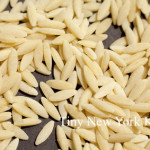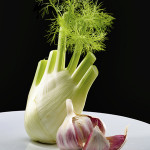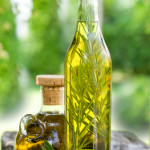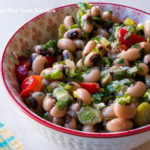For cooking, seek out small, sweet varieties with a thick flesh and a fairly small seed cavity, such as the Sugar, Pie, Baby Bear, or Cheese pumpkin. Field pumpkins have a fibrous flesh that is not good for cooking. Keep them for jack-o’-lanterns.
For convenience, you can use canned pumpkin puree. Some are unsweetened and plain, while others, labeled as pie filling, include sugar and spices. It’s also easy to make your own puree.
Choose pumpkins that feel solid and heavy for their size. As pumpkins age, they dry out and become lighter. The skin should be hard with no cracks, blemishes or soft spots.
Hard shells protect pumpkins from easy spoilage. Most will keep for a month or longer if stored in a cool, dry place. Once cut, pumpkins should be wrapped tightly in plastic, refrigerated and used within 3 to 4 days.
To cut open a pumpkin, steady it on a thick towel, very carefully insert a large, heavy knife near the stem and cut down through the curved side. Always cut away from you. Turn the pumpkin 180 degrees and repeat on the other side. A more dramatic, messier method is simply to drop the pumpkin onto newspapers spread on a hard floor. The pumpkin will break into pieces.
Once you’ve cracked into the pumpkin use a large metal spoon to scrape out the seeds and any fibrous strings in the seed cavity. Save the seeds for roasting if you want to.
“Work With What You Got!”
© Victoria Hart Glavin Tiny New York Kitchen © 2017 All Rights Reserved
Whether you’re baking summer pies or getting ready for holiday baking it’s important to have some key information about pie dough.
Blind Baking
Blind baking is prebaking a crust before you add an unbaked or especially wet filling. To ensure that your crust turns out crisp while blind baking, you can either dock it or use pie weights.
Docking
Docking is pricking the dough all over with the tines of a fork. The tiny holes allow steam to escape, so that the crust doesn’t puff up. After rolling out your dough and pressing it into the pan, gently prick it, leaving an inch or two between each mark. Be sure to check your crust several times throughout its bake time. If you notice it puffing up in any way, simply prick the puffy spots a few times and keep baking.
Pie Weights
Pie weights are tiny ceramic or metal balls or a thin metal chain that prevent the bottom of your crust from forming air pockets and bubbling up while baking. While docking is less fussy than using pie weights, I prefer pie weights because of the additional support they give the crust. Line your unbaked crust with parchment paper or aluminum foil before adding the weights to keep them from baking into the dough. I prefer parchment paper because its permeable structure allows the crust to breathe and brown more evenly. If you don’t own pie weights, dried beans work just as well.
Blind Bake Ahead
You can blind bake a crust up to three days ahead of time. Allow the crust to cool completely in the pan, wrap with plastic wrap, and store at room temperature until you are ready to fill and serve.
Happy Pie Baking!
“Work With What You Got!”
© Victoria Hart Glavin Tiny New York Kitchen © 2017 All Rights Reserved
The end of summer is fresh produce heaven, which includes delicious vine ripened tomatoes. What do you do when you have a tomato abundance?
Here are some tips for making the most of the end of summer tomatoes.
Sliced: Incorporate into sandwiches or add to basil and mozzarella for a Caprese Salad.
Chopped: You only need a few chopped heirloom tomatoes, mozzarella, chopped basil, and olive oil for a colorful no-cook pasta sauce.
Puréed: There’s nothing like an icy cold gazpacho on a warm day.
Salsa: Fresh salsa is a must have condiment for grilled steaks or shrimp, brown rice and beans, scrambled eggs, and of course, chips.
Grilled: Toss cherry tomatoes with olive oil, garlic, and herbs. Then cook in a grill basket until charred. Top fish, chicken, pasta, and charred slices of bread.
Stored: Keep tomatoes at room temperature until ripe and then use within a day or two. Don’t put them in the refrigerator as it affects their flavor and texture.
Preserved: Roasted, dehydrated, or stewed – savor the season by saving a taste of summer for later.
“Work With What You Got!”
© Victoria Hart Glavin Tiny New York Kitchen © 2017 All Rights Reserved
Even though summer is not technically over I’m in the fall baking mood. Yesterday was a rainy day here in New England. I made Gooey Rocky Road Brownies and I had to stop myself from eating the entire batch.
From Concord to Emperor, there are so many delicious grape varieties available.
Whether tossed in a salad, baked into a dessert, or straight off the vine, these bite-size globes are packed with flavor.
Bursting with fiber, vitamin C, and loads of antioxidants, this fruit packs a nutritional punch as big as flavor. Grapes make an ideal portable snack in less than 100 calories per cup.
Look for firm grapes that are brightly colored and securely attached to their stems. Avoid bundles with wrinkled, dull skin or packages that have a lot of fruit floating at the bottom of the bag. When all else fails, try one.
Although there are thousands of varieties of grapes, the most popular are Thompson and Emperor seedless. Thompson grapes are sweet and crisp with vibrant green skin, amazing for snacking. Emperor red grapes have a sweet and tart flavor and are super juicy, making them great for baking.
Emperor or Flame: With their sweet flavor and long shelf life, these large seedless grapes are one of the most popular varieties.
Thompson Green: In America, 90% of these classic green grapes are produced in California. They are used for snacking, making wine, and raisins.
Concord: Created in Concord, Massachusetts, these grapes are known for their thick, blush skin and sweet candy-like flavor.
Freeze Them: Pick grapes off the vine and place them in a resealable plastic bag. Freeze overnight for a healthy, frosty treat.
Bake Them: To make raisins at home, cook grapes for 30 seconds in boiling water and place in a bowl of ice water. Preheat the oven to 170 degrees and place grapes on a parchment paper lined baking sheet. Bake until they have dried out completely. Toss grapes halfway through to prevent sticking.
Blend Them: Blend grapes with a bit of water and pour through a fine mesh strainer for a fresh glass of grape juice.
“Work With What You Got!”
© Victoria Hart Glavin Tiny New York Kitchen © 2017 All Rights Reserved
Orzo is the Italian word for barley; however, orzo is not made from barley at all, but rather from semolina, which is a course ground flour made from durum wheat. With its shape reminiscent of slivered almonds, orzo cooks up in about half the time of rice, making it a speedy standby to have on hand to add heartiness to meals.
Just bring 3 quarts of lightly salted water to a boil. Add 8 ounces ( 1 1/2 cups) dried orzo and boil about 10 minutes until it has a firm, chewy texture. Stir occasionally to prevent it from sticking together. Drain orzo in colander and serve immediately.
Rinse orzo only if it will be baked or served cold in a salad. Otherwise, do not rinse as rinsing removes a light coating of starch that helps sauces and seasonings cling to the pasta.
For the best texture and flavor serve orzo immediately after cooking. If your orzo gets done before the rest of the meal, you can keep it warm by returning the cooked drained pasta to the warm cooking pan. Stir in a little butter or olive oil to prevent it from sticking together. Cover the pasta with a lid and let it stand no more than 14 minutes.
“Work With What You Got!”
© Victoria Hart Glavin Tiny New York Kitchen © 2017 All Rights Reserved
Mahatma Gandhi, as you know, walked barefoot most of the time, which produced an impressive set of calluses on his feet. He also ate very little, which made him rather frail and, with his odd diet, he suffered from bad breath. This made him a super calloused fragile mystic hexed by halitosis.
“Work With What You Got!”
© Victoria Hart Glavin Tiny New York Kitchen © 2017 All Rights Reserved
Fennel is a flowering plant species that is in the carrot family. Indigenous to the Mediterranean, fennel is now grown in many parts of the world with dry soil, near seacoasts, and on riverbanks.
Fennel is highly aromatic and flavorful with culinary and medicinal uses. Florence Fennel (or Finocchio) is used as a vegetable and is one of the three main herbs used in preparation of absinthe, an alcoholic mixture that originated as a medicinal elixir in Switzerland and became, by the late 19th century, a popular alcoholic drink in France and other countries.
Fennel bulb, foliage, and seeds are used in many culinary traditions around the world. The small flowers of wild fennel (fennel pollen) are the most potent form of fennel and are also the most expensive. Dried fennel seeds are an aromatic, anise-flavored spice that are brown or green in color when fresh, and slowly turn a dull grey as the seeds age. Green seeds are the best for cooking. Fennel seeds are sometimes confused with anise, which are similar in taste and appearance, though smaller. Fennel seeds are the primary flavor component in Italian sausage.
Fennel leaves are delicately flavored and are similar, in shape, to those of dill. The bulb itself is a crisp vegetable that can be sautéed, stewed, braised, grilled, or eaten raw. Young tender leaves are used for garnishes, as a salad to add flavor to salads, to flavor sauces, in soups, and fish sauce. Fennel leaves are used in some parts of India as leafy green vegetables either by themselves or mixed with other vegetables. In Syria and Lebanon young fennel leaves are used to make a special kind of egg omelet (with onions and flour) called ijjeh.
Florence fennel is a key ingredient in some German and Italian salads that are often tossed with chicory and avocado. It can be braised and served as a warm side dish. It can also be blanched, marinated, or cooked in risotto. In Spain the stems of the fennel plant are used in the preparation of pickled eggplant called berenjenas de almagro. In Israel fennel salad is made of chopped fennel bulbs flavored with salt, black pepper, parsley, olive oil, and sometimes sumac.
“Work With What You Got!”
© Victoria Hart Glavin Tiny New York Kitchen © 2017 All Rights Reserved
Oh, Martha’s Vineyard, I’m Coming Home. I’m Going To See The Place I Love. How Long Can I Hang Around? Until My Skin Turns Brown. Oh, Martha’s Vineyard, I’m Coming Home!
“Work With What You Got!”
© Victoria Hart Glavin Tiny New York Kitchen © 2017 All Rights Reserved
One of the best ways to preserve the abundance of fresh herbs from your garden is by making flavored oils. Herb oils can be enjoyed so many ways – drizzled over salads, vegetables, pastas, sandwiches, or grilled items, hot or cold or at room temperature. Not only are they flavorful, but they also add dramatic color when drizzled on plates. If you want to add more flavor add half a clove of smashed garlic and 1/2 teaspoon crushed red pepper to the blender with the other ingredients, which makes a great dipping oil for chunks of rustic bread.
“Work With What You Got!”
© Victoria Hart Glavin Tiny New York Kitchen © 2017 All Rights Reserved















